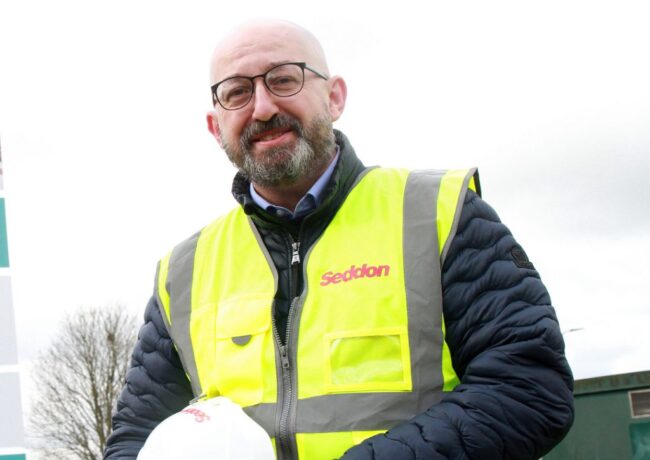INTERVIEW | Seddon’s strategy for survival and success
“There are no Lamborghinis in the car park,” pointed out managing director Peter Jackson as he sat down with Place North West to discuss how the company keeps its head while others are losing theirs.
Gesturing out of the window of the boardroom at the company’s Bolton HQ, Jackson said that the lack of sports cars is a reflection of how the company operates.
“The owners are humble and that makes us resilient. That is how we have got to 125 years,” he said.
The construction company’s 125-year anniversary comes at a challenging time for the industry, during which family-owned Seddon has worked hard to minimise its exposure to risk and maintain its reputation as a safe pair of hands.
“People keep telling me I am risk-averse, so I must be,” Jackson joked.
This approach is expected to see the company record turnover of £178m when it publishes its financial results for 2021.
This figure, while down on the £200m revenue recorded in 2020, is probably beyond the wildest dreams of founders John and George Seddon, whose head office when the firm was established in 1897 was a horse and cart behind a pub in Little Hulton.
The key figure to look out for, though, is Jackson’s aim of a 5% net margin. A target that many similarly-sized firms could only dream of.
In the last two years, a host of Seddon’s rivals in the North West have collapsed. Administrators’ reports have cited pandemic pressures, problem jobs, and rocketing material prices as reasons behind the demise of companies such as Cruden Construction, CPUK and others.
Those pressures are felt throughout the built environment.
“As an industry, we have got to change the way we think about stuff,” Jackson said.
This means looking more closely at, and having a better understanding of, cost. It also means refusing to take on work if you cannot afford it, he explained.
He thinks the construction industry needs a “cultural reboot” with regard to how jobs are procured, referring to the much-talked-about race to the bottom, whereby contractors bid low to win work but often struggle to make a profit.
It is a race run on the need to maintain cash flow, with no real winners and lots of losers.

Jackson credits the company’s success to the owners’ humble approach. From left:
Nicola Hodkinson, Josh Hodkinson, Jonathan Seddon, Matt Hodkinson, Jamie Seddon. Credit: via Rumpus PR
Seddon has managed to avoid it for the most part, Jackson said, but many others have disappeared chasing impossibly low margins.
“We should be competing with a cost plan, not with who’s going to be kamikaze on tender prices. That’s where we try to position ourselves,” he said.
If a client puts an unrealistic price tag on a job, it places most of the risk on the contractor.
However, if the contractor subsequently goes bust, the client could end up having to fork out more in the long run.
“We’re finishing buildings after contractors have gone into administration and it is costing twice as much because they had the wrong starting price,” Jackson said.
Having seen so many firms go to the wall as a result of unbalanced risk profiles, Seddon has become more discerning about the kind of work it takes on.
This means a growing focus on frameworks, where relationships can be formed. This results in more open dialogue between contractor and client, Jackson said.
Since Jackson arrived in 2005, the number of frameworks the company is on has jumped from one to 50.
“A lot of effort has gone into that,” Jackson said. “We wanted that visibility and to see our long-term pipeline.”
That visibility allows Seddon to plan, whether that’s in terms of developing its supply chain or growing its direct workforce, which currently stands at 200.
Frameworks also give Seddon a chance to collaborate more effectively with clients and iron out issues at an early stage, limiting nasty surprises later down the line, Jackson explained.
Another risk management tactic Seddon has adopted in recent years is to reduce its reliance on large projects.
Schemes valued at more than £10m used to account for around £90m of the group’s overall turnover but this has decreased to around £40m in recent years, Jackson pointed out.
“I don’t want the big stuff to be more than 40% of our overall turnover from a risk management point of view.
“That limits us but it also makes us really focused on selecting the right customers. You have got to know who you are working with.”
Much of the company’s focus these days is on housing partnerships. This side of the business has risen in revenue terms from £45m to £100m in the last five years and affords Seddon more opportunities for collaboration and dialogue, thus reducing risk.
Another side of the business that is growing is property services. This is a conscious decision from the owners. Painting jobs, for example, can be done quickly, so price inflation is less of an issue compared to higher value projects that take two or three years to deliver.
By focussing on smaller, lower-profile jobs, Seddon has made itself more resilient and better able to weather the storms of recent years. But does this approach amount to a lack of ambition?
Jackson thinks that is the wrong way of looking at the situation.
“Is it a lack of ambition, or is that long-termism versus short-termism? People who have been gung-ho and jumped into bigger work and the wrong work are no longer here,” he said.
Perhaps the starkest example of Seddon’s longevity in contrast to the wider market came recently when Crossfield Construction announced it was going into voluntary liquidation.
With Crossfield becoming the latest casualty of the race to the bottom, Salford City Council was required to look for another contractor for a 177-home development in Little Hulton.
In stepped Seddon.
The company plans to start that job later this year, in a return to the company’s roots.
The site is just a 10-minute walk from where George and John first started out behind the Horseshoe pub 125 years ago.






He makes a lot of good points. Contracting is very much about client and supply chain relationships. It isn’t a get rich quick business, its a long term steady sector where margins aren’t fantastic but for the most part its cashflow positive. However what does need to be acknowledged is that costs in the UK are one of the highest in western europe so its not just about cost being added for the client. The sector is woefully inefficient and all contracting organisations need to take ownership of this issue as that is where the gains need to be made.
By BDAY
When I began my career in the construction industry some 40 years ago, a lecturer at the then Liverpool Polytechnic extolled that rather than tendering on the “first past the post” method, Contractors tenders should be awarded on the “second based” principle where the 2 tender was chosen rather than the cheapest and this would result in Contractors be able to fully plan, resource and programme their offers based on realistic deliverable cost with sustainable margins.
Tendering on framework initiatives goes some way to addressing this but unfortunately and it is becoming more noticeable, unrealistic cost plans from supposedly experienced and knowledgeable cost planners employed by the Employer is diluting the effectiveness of securing framework projects with Contractors often being put into the position of cutting their offers to close as close to the Employers Cost Plan figure.
Mr Jackson is correct when he says the construction industry requires a “cultural reboot” but I fear in a further 40 years time, we will still be talking of “first past the post” tendering.
By IR